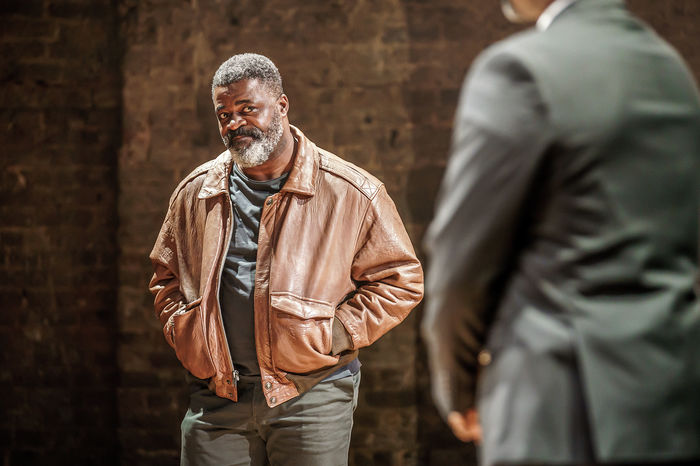Good Grief: a play at odds with its theatrical form
Joshua Robey reviews Good Grief, now streaming until 15th April through Original Theatre Online, and explores its relation to previous incarnations of “pandemic theatre” in the COVID era.
The last year has necessitated the adaptation of theatre – not only in restrictions on audiences, the rise of onstage social distancing, and the increasingly ubiquitous idea of a ‘streaming production’, but also in the implications for the term ‘theatre’ itself. So much of what might be termed ‘pandemic theatre’ has suggested that ‘theatre’ refers to both an ineffable process that happens onstage and the space in which this process occurs.
The Old Vic have now live-streamed three plays with a backdrop of empty seats, the online audience viewing the reverse of the standard in-person experience. Meanwhile, a recent streamed production of Romeo and Juliet was filmed against greenscreens, but still felt the pull of the theatre building – setting the action on a computer-generated stage and superimposing Derek Jacobi into the circle.
“...the pandemic has forced the issue of what constitutes theatre into mainstream critical discussion.”
Ten years ago, in the early days of National Theatre Live – which streams productions to cinemas across the world – playwright Chris Goode criticised the very idea of streaming a play as ‘wrongheaded’, in that ‘it treats a piece of theatre as information, as streamable content’. He contended that what makes something ‘theatre’ is an issue of form rather than content – a cinemagoer, or now, home-streamer only receives the content. For Goode, without the theatrical act of gathering as an audience in one room, theatre is not taking place.
Even before the pandemic, Goode – like many other detractors – had conceded some of the possibilities of making the experience of theatre less London-centric. Yet the pandemic has forced the issue of what constitutes theatre into mainstream critical discussion. Speaking at a Young Vic Zoom event on theatre criticism last week, Arifa Akbar noted that the onset of ‘hybrid theatre’ has inevitably forced questions such as ‘What is theatre?’, ‘Who is theatre for?’ and ‘How sustainable is it?’ into regular discussion. At the same event, Dominic Cavendish suggested that the Old Vic’s In Camera series of streamed plays amounted to a ‘provocation’. Productions themselves must inherently reflect on their formal status as part of their marketing, when choosing whether to call themselves ‘theatre’ and if not, then what?
"Good Grief does feel rather insubstantial, though, some of which may be attributed to its uncertain form.”
These questions are hinted at by Lorien Haynes’ affecting though flawed new play Good Grief, in which Sian Clifford and Nikesh Patel play old friends, reeling from the death of his wife, whilst negotiating the feelings they begin to have for each other. The play not only lacks an audience but was filmed on a COVID-compliant set rather than in a theatre (like the recent streaming output from the Old Vic or Almeida). Rehearsed for two days on Zoom, its production process was far closer to that of television – which does not allow nearly as much time for the performances to develop. Perhaps one of the most striking differences with most online theatre, however, is the cast members’ proximity to each other. Good Grief was made under the guidelines that have now become industry standard for television and film production, rather than the more cautious ones generally adopted by theatres.
The production acknowledges its somewhat uncertain status, opening with black and white footage of masked crew members setting up for the first scene. They recur throughout, a curious imitation of the scene changes required for a live performance, yet one that underscores its difference. Some might find these scenes a jarring distraction from the play itself, yet they situate the audience in an interestingly conscious relation to the drama; we are made to face its fictionality in a way that is arguably itself theatrical – the production becoming a meta-theatre of sorts.
When interviewed in the Financial Times, the play’s director Natalie Abrahami argued that the setting deliberately has a ‘very rough aesthetic’. The space variously becomes both of their houses, a hotel room, and an IKEA car park, a flexibility that Abrahami argued necessitates an audience: ‘We need you — without you this doesn’t make sense.’ The largely prop-free productions from the Old Vic have a similar gesture. Lungs asks its audience to imagine a range of settings from a couple’s home to (again) IKEA, whilst Three Kings – the Old Vic’s best online production so far – starred only Andrew Scott and three hauntingly-used one-pound coins.
Good Grief does feel rather insubstantial, though, some of which may be attributed to its uncertain form. The longstanding closeness between the play’s two characters was something the play tells us about, rather than something we are made to feel. More jarring is the way in which the dialogue’s rhythm falls uncomfortably between that of television and theatre. The lingering pauses perhaps more associated with the stage are not quite long enough to feel deliberate, the effect unfortunately seeming the product of a slack edit, rather than a theatrical choice. It might have benefited from a more static approach to filming. At times, you just wish you could see both characters – and their interactions – in one shot.
Haynes’ play is a well-handled and sometimes moving consideration of its central subject – and its insights on grief, and the guilt that can accompany it, are compelling. Although I have no qualms about calling Good Grief ‘theatre’ – the term being inherently adaptable, especially in conditions such as the ongoing pandemic – the play’s focused approach to its content is rather at odds with its hesitancy over form.
 News / SU reluctantly registers controversial women’s soc18 December 2025
News / SU reluctantly registers controversial women’s soc18 December 2025 Features / Should I stay or should I go? Cambridge students and alumni reflect on how their memories stay with them15 December 2025
Features / Should I stay or should I go? Cambridge students and alumni reflect on how their memories stay with them15 December 2025 News / Dons warn PM about Vet School closure16 December 2025
News / Dons warn PM about Vet School closure16 December 2025 News / Cambridge study finds students learn better with notes than AI13 December 2025
News / Cambridge study finds students learn better with notes than AI13 December 2025 News / Uni registers controversial new women’s society28 November 2025
News / Uni registers controversial new women’s society28 November 2025










